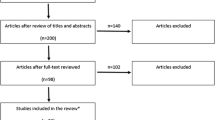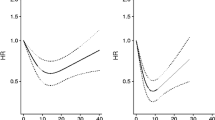Abstract
BACKGROUND
Alcohol consumption is a common behavior. Little is known about the relationship between alcohol consumption and glycemic control among people with diabetes.
OBJECTIVE
To evaluate the association between alcohol consumption and glycemic control.
DESIGN
Survey follow-up study, 1994–1997, among Kaiser Permanente Northern California members.
PATIENTS
38,564 adult diabetes patients.
MEASUREMENTS
Self-reported alcohol consumption, and hemoglobin A1C (A1C), assessed within 1 year of survey date. Linear regression of A1C by alcohol consumption was performed, adjusted for sociodemographic variables, clinical variables, and diabetes disease severity. Least squares means estimates were derived.
RESULTS
In multivariate-adjusted models, A1C values were 8.88 (lifetime abstainers), 8.79 (former drinkers), 8.90 (<0.1 drink/day), 8.71 (0.1–0.9 drink/day), 8.51 (1–1.9 drinks/day), 8.39 (2–2.9 drinks/day), and 8.47 (≥3 drinks/day). Alcohol consumption was linearly (p < 0.001) and inversely (p = 0.001) associated with A1C among diabetes patients.
CONCLUSIONS
Alcohol consumption is inversely associated with glycemic control among diabetes patients. This supports current clinical guidelines for moderate levels of alcohol consumption among diabetes patients. As glycemic control affects incidence of complications of diabetes, the lower A1C levels associated with moderate alcohol consumption may translate into lower risk for complications.


Similar content being viewed by others
References
Mokdad AH, Ford ES, Bowman BA et al. Prevalence of obesity, diabetes, and obesity-related health risk factors, 2001. JAMA. 2003;289:76–9.
Armstrong DG, Lavery LA, van Houtum WH, Harkless LB. The impact of gender on amputation. J Foot Ankle Surg. 1997;36:66–9.
Morris AD, McAlpine R, Steinke D et al. Diabetes and lower-limb amputations in the community. A retrospective cohort study. DARTS/MEMO Collaboration. Diabetes Audit and Research in Tayside Scotland/Medicines Monitoring Unit. Diabetes Care. 1998;21:738–43.
Most RS, Sinnock P. The epidemiology of lower extremity amputations in diabetic individuals. Diabetes Care. 1983;6:87–91.
Siitonen OI, Niskanen LK, Laakso M, Siitonen JT, Pyorala K. Lower-extremity amputations in diabetic and nondiabetic patients. A population-based study in eastern Finland. Diabetes Care. 1993;16:16–20.
Trautner C, Haastert B, Giani G, Berger M. Incidence of lower limb amputations and diabetes. Diabetes Care. 1996;19:1006–9.
USRDS. USRDS 2001 Annual Data Report: Atlas of End-Stage Renal Disease in the United States. 2001. Bethesda, MD. Tertiary USRDS 2001 Annual Data Report: Atlas of End-Stage Renal Disease in the United States.
van Houtum WH, Lavery LA, Harkless LB. The impact of diabetes-related lower-extremity amputations in The Netherlands. J Diabetes Complications. 1996;10:325–30.
Hogan P, Dall T, Nikolov P. Economic costs of diabetes in the US in 2002. Diabetes Care. 2003;26:917–32.
Standards of medical care in diabetes—2006. Diabetes Care. 2006;29 Suppl 1:S4–42.
Koro CE, Bowlin SJ, Bourgeois N, Fedder DO. Glycemic control from 1988 to 2000 among U.S. adults diagnosed with type 2 diabetes: a preliminary report. Diabetes Care. 2004;27:17–20.
Substance Abuse and Mental Health Services Administration. Overview of Findings from the 2003 National Survey on Drug Use and Health. 2004. Rockville, MD. Tertiary Overview of Findings from the 2003 National Survey on Drug Use and Health.
Carlsson S, Hammar N, Grill V, Kaprio J. Alcohol consumption and the incidence of type 2 diabetes: a 20-year follow-up of the Finnish twin cohort study. Diabetes Care. 2003;26:2785–90.
Howard AA, Arnsten JH, Gourevitch MN. Effect of alcohol consumption on diabetes mellitus: a systematic review. Ann Intern Med. 2004;140:211–9.
Lu W, Jablonski KA, Resnick HE et al. Alcohol intake and glycemia in American Indians: the strong heart study. Metabolism. 2003;52:129–35.
Nakanishi N, Suzuki K, Tatara K. Alcohol consumption and risk for development of impaired fasting glucose or type 2 diabetes in middle-aged Japanese men. Diabetes Care. 2003;26:48–54.
Wannamethee SG, Camargo CA, Jr., Manson JE, Willett WC, Rimm EB. Alcohol drinking patterns and risk of type 2 diabetes mellitus among younger women. Arch Intern Med. 2003;163:1329–36.
Watanabe M, Barzi F, Neal B et al. Alcohol consumption and the risk of diabetes by body mass index levels in a cohort of 5,636 Japanese. Diabetes Res Clin Pract. 2002;57:191–7.
Franz MJ, Bantle JP, Beebe CA et al. Nutrition principles and recommendations in diabetes. Diabetes Care. 2004;27(Suppl 1):S36–46.
Gordon NP, Kaplan GA. Some evidence refuting the HMO “favorable selection” hypothesis: the case of Kaiser Permanente. Adv Health Econ Health Serv Res. 1991;12:19–39.
Hiatt RA, Friedman GD. Characteristics of patients referred for treatment of end-stage renal disease in a defined population. Am J Public Health. 1982;72:829–33.
Krieger N. Overcoming the absence of socioeconomic data in medical records: validation and application of a census-based methodology. Am J Public Health. 1992;82:703–10.
Ferrara A, Karter AJ, Ackerson LM, Liu JY, Selby JV. Hormone replacement therapy is associated with better glycemic control in women with type 2 diabetes: The Northern California Kaiser Permanente Diabetes Registry. Diabetes Care. 2001;24:1144–50.
Iribarren C, Karter AJ, Go AS et al. Glycemic control and heart failure among adult patients with diabetes. Circulation. 2001;103:2668–73.
Karter AJ, Rowell SE, Ackerson LM et al. Excess maternal transmission of type 2 diabetes. The Northern California Kaiser Permanente Diabetes Registry. Diabetes Care. 1999;22:938–43.
Karter AJ, Ferrara A, Darbinian JA, Ackerson LM, Selby JV. Self-monitoring of blood glucose: language and financial barriers in a managed care population with diabetes. Diabetes Care. 2000;23:477–83.
Karter AJ, Ackerson LM, Darbinian JA et al. Self-monitoring of blood glucose levels and glycemic control: the Northern California Kaiser Permanente Diabetes registry. Am J Med. 2001;111:1–9.
Karter AJ, Ferrara A, Liu JY, Moffet HH, Ackerson LM, Selby JV. Ethnic disparities in diabetic complications in an insured population. JAMA. 2002;287:2519–27.
Selby JV, Ray GT, Zhang D, Colby CJ. Excess costs of medical care for patients with diabetes in a managed care population. Diabetes Care. 1997;20:1396–402.
Selby JV, Ettinger B, Swain BE, Brown JB. First 20 months’ experience with use of metformin for type 2 diabetes in a large health maintenance organization. Diabetes Care. 1999;22:38–44.
Selby JV, Karter AJ, Ackerson LM, Ferrara A, Liu J. Developing a prediction rule from automated clinical databases to identify high-risk patients in a large population with diabetes. Diabetes Care. 2001;24:1547–55.
Gual A, Segura L, Contel M, Heather N, Colom J. Audit-3 and audit-4: effectiveness of two short forms of the alcohol use disorders identification test. Alcohol Alcohol. 2002;37:591–6.
Gronbaek M, Heitmann BL. Validity of self-reported intakes of wine, beer and spirits in population studies. Eur J Clin Nutr. 1996;50:487–90.
Friesema IH, Veenstra MY, Zwietering PJ, Knottnerus JA, Garretsen HF, Lemmens PH. Measurement of lifetime alcohol intake: utility of a self-administered questionnaire. Am J Epidemiol. 2004;159:809–17.
Harris TR, Wilsnack RW, Klassen AD. Reliability of retrospective self-reports of alcohol consumption among women: data from a U.S. national sample. J Stud Alcohol. 1994;55:309–14.
Bongers IM, van Oers JA. Mode effects on self-reported alcohol use and problem drinking: mail questionnaires and personal interviewing compared. J Stud Alcohol. 1998;59:280–5.
Steiner JF, Koepsell TD, Fihn SD, Inui TS. A general method of compliance assessment using centralized pharmacy records. Description and validation. Med Care. 1988;26:814–23.
Li CL, Tsai ST, Chou P. Persistent impaired glucose tolerance, insulin resistance, and beta-cell dysfunction were independent predictors of type 2 diabetes. J Clin Epidemiol. 2005;58:728–32.
Caballero AE. Endothelial dysfunction, inflammation, and insulin resistance: a focus on subjects at risk for type 2 diabetes. Curr Diab Rep. 2004;4:237–46.
Qiao Q, Tuomilehto J, Balkau B, Borch-Johnsen K, Heine R, Wareham NJ. Are insulin resistance, impaired fasting glucose and impaired glucose tolerance all equally strongly related to age? Diabet Med. 2005;22:1476–81.
Mackenzie T, Brooks B, O’Connor G. Beverage intake, diabetes, and glucose control of adults in America. Ann Epidemiol. 2006;16:688–91.
Shai I, Wainstein J, Harman-Boehm I et al. Glycemic effects of moderate alcohol intake among patients with type 2 diabetes: A Multi-center, randomized clinical intervention trial. Diabetes Care. 2007.
Avogaro A, Watanabe RM, Gottardo L, de Kreutzenberg S, Tiengo A, Pacini G. Glucose tolerance during moderate alcohol intake: insights on insulin action from glucose/lactate dynamics. J Clin Endocrinol Metab. 2002;87:1233–38.
Facchini F, Chen YD, Reaven GM. Light-to-moderate alcohol intake is associated with enhanced insulin sensitivity. Diabetes Care. 1994;17:115–9.
Hodge AM, Dowse GK, Collins VR, Zimmet PZ. Abnormal glucose tolerance and alcohol consumption in three populations at high risk of non-insulin-dependent diabetes mellitus. Am J Epidemiol. 1993;137:178–89.
Kiechl S, Willeit J, Poewe W et al. Insulin sensitivity and regular alcohol consumption: large, prospective, cross sectional population study (Bruneck study). Bmj. 1996;313:1040–44.
Mayer EJ, Newman B, Quesenberry CP, Jr., Friedman GD, Selby JV. Alcohol consumption and insulin concentrations. Role of insulin in associations of alcohol intake with high-density lipoprotein cholesterol and triglycerides. Circulation. 1993;88:2190–7.
Razay G, Heaton KW, Bolton CH, Hughes AO. Alcohol consumption and its relation to cardiovascular risk factors in British women. Bmj. 1992;304:80–3.
Zilkens RR, Puddey IB. Alcohol and cardiovascular disease—more than one paradox to consider. Alcohol and type 2 diabetes—another paradox? J Cardiovasc Risk. 2003;10:25–30.
Meyer KA, Conigrave KM, Chu NF et al. Alcohol consumption patterns and HbA1c, C-peptide and insulin concentrations in men. J Am Coll Nutr. 2003;22:185–94.
Bell RA, Mayer-Davis EJ, Martin MA, D’Agostino RB, Jr., Haffner SM. Associations between alcohol consumption and insulin sensitivity and cardiovascular disease risk factors: the Insulin Resistance and Atherosclerosis Study. Diabetes Care. 2000;23:1630–36.
Harding AH, Sargeant LA, Khaw KT et al. Cross-sectional association between total level and type of alcohol consumption and glycosylated haemoglobin level: the EPIC-Norfolk Study. Eur J Clin Nutr. 2002;56:882–90.
Kroenke CH, Chu NF, Rifai N et al. A cross-sectional study of alcohol consumption patterns and biologic markers of glycemic control among 459 women. Diabetes Care. 2003;26:1971–8.
Gulliford MC, Ukoumunne OC. Determinants of glycated haemoglobin in the general population: associations with diet, alcohol and cigarette smoking. Eur J Clin Nutr. 2001;55:615–23.
Davies MJ, Baer DJ, Judd JT, Brown ED, Campbell WS, Taylor PR. Effects of moderate alcohol intake on fasting insulin and glucose concentrations and insulin sensitivity in postmenopausal women: a randomized controlled trial. JAMA. 2002;287:2559–62.
Sierksma A, Patel H, Ouchi N et al. Effect of moderate alcohol consumption on adiponectin, tumor necrosis factor-alpha, and insulin sensitivity. Diabetes Care. 2004;27:184–9.
Reijneveld SA, Stronks K. The impact of response bias on estimates of health care utilization in a metropolitan area: the use of administrative data. Int J Epidemiol. 1999;28:1134–40.
Benfante R, Reed D, MacLean C, Kagan A. Response bias in the Honolulu Heart Program. Am J Epidemiol. 1989;130:1088–100.
Harald K, Salomaa V, Jousilahti P, Koskinen S, Vartiainen E. Non-participation and mortality in different socioeconomic groups: the FINRISK population surveys in 1972–92. J Epidemiol Community Health. 2007;61:449–54.
Van Loon AJ, Tijhuis M, Picavet HS, Surtees PG, Ormel J. Survey non-response in the Netherlands: effects on prevalence estimates and associations. Ann Epidemiol. 2003;13:105–10.
Gordon NP, Kaplan GA. Some evidence refuting the HMO "favorable selection" hypothesis: the case of Kaiser Permanente. Adv Health Econ Health Serv Res. 1991;12:19–39.
Ahmed AT, Karter AJ, Liu JY. Alcohol consumption is inversely associated with adherence to diabetes self-care behaviors. Diabet Med. 2006;23:795–802.
Effect of intensive blood-glucose control with metformin on complications in overweight patients with type 2 diabetes (UKPDS 34). UK Prospective Diabetes Study (UKPDS) Group. Lancet. 1998;352:854–65.
Stratton IM, Adler AI, Neil HA et al. Association of glycaemia with macrovascular and microvascular complications of type 2 diabetes (UKPDS 35): prospective observational study. BMJ. 2000;321:405–12.
Acknowledgments
The authors thank Drs. Joe Selby and Robert Lipton for their helpful suggestions. This study was funded by NIAAA (R21 AA015721-01A1) and by the Kaiser Community Benefits Fund. Preliminary study findings were presented in abstract form at the Addictions Health Services Research Conference, October 23–25, 2006, Little Rock, AK.
Conflict of Interest
None disclosed.
Author information
Authors and Affiliations
Corresponding author
Rights and permissions
About this article
Cite this article
Ahmed, A.T., Karter, A.J., Warton, E.M. et al. The Relationship Between Alcohol Consumption and Glycemic Control Among Patients with Diabetes: The Kaiser Permanente Northern California Diabetes Registry. J GEN INTERN MED 23, 275–282 (2008). https://doi.org/10.1007/s11606-007-0502-z
Received:
Revised:
Accepted:
Published:
Issue Date:
DOI: https://doi.org/10.1007/s11606-007-0502-z




